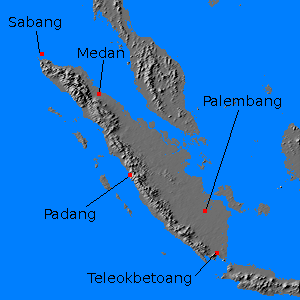![]() The Pacific War Online Encyclopedia
The Pacific War Online Encyclopedia
|
| Previous: Sultan, Daniel I. | Table of Contents | Next: Sumatra Class, Dutch Light Cruisers |

Sumatra is the second largest island in the Netherlands East Indies and the fourth largest in the world, with an area of 182,859 square miles (473,600 km2). A mountain chain, the Barisan Gebergte, runs the entire length of the Indian Ocean coast and varies from 5000' to 12000' (1500 to 3700 meters) in elevation with the highest point at Mount Kerinji, southeast of Padang (12,483' or 3805 meters). There is only a narrow coastal plain southwest of the mountains. The lower two thirds of the island northeast of the mountains is a broad alluvial plain covered by jungle, which is bordered by extensive swamps along the coast. The northwestern third of the island has a much narrower coastal plain northeast of the mountains, but this is free of swamps. There are several large rivers draining into the northeast coast, including the Musi River, which had a dredged channel for small oceangoing ships as far as Palembang, and the Hari River to its northwest, which had a navigable length of 300 miles (500 km).
The largest towns were Medan in the north, Palembang and Teleokbetoang in the south, and Padang on the Indian Ocean coast. The port of Sabang, a small island just off the western tip of Sumatra, was the westernmost port in the Netherlands East Indies. The interior of the lower two-thirds of Sumatra, inland of the coastal swamps, was the primary agricultural region. Although the island had a significant road network, including a road along most of the southwest coast and roads crossing the mountains into the agricultural interior, most of the southeastern two-thirds of the northeast coast was inaccessible by road. However, there was a road and rail system along the northern third of the northeast coast. Another rail system connected Palembang with Teleokbetoang. Total rail mileage was 1139 miles (1833 km). There was also a regular ferry from Teleokbetoang to Java. There was a primitive telephone and telegraph system connecting the major cities.
The island was visited by Marco Polo in the late 13th century and Europeans began to establish fortified settlements in the 16th century. The island was dominated at that time by the Aceh Sultanate. The British and Dutch vied for control until 1871, when the British concluded a treaty that ended their support for Aceh and effectively consigned Sumatra to the Dutch sphere of influence. However, the Dutch did not establish full control of the island until the surrender of the last Aceh sultan in 1903.
The population of Sumatra and its neighboring islands
was about 2,300,000 persons. About 6000 of these were Europeans and
153,000 Asians and Arabs (predominantly Chinese.)
Sumatra's jungles
concealed great wealth in the form of rich oil
fields.
Those around the city of Palembang
had been producing since 1907, accounted for half
the oil production of the Netherlands East Indies, and produced oil
that was particularly
rich in the valuable lighter fractions, such as gasoline. There was
also significant production of coal
at Ombilin in the mountains
northeast of Padang, at Boekit Asam
southwest of Palembang, and other localities, though most of this was
consumed locally. The island also produced rubber and other agricultural products.
When war broke out in the Pacific, the island had fourteen airfields and was defended by 4500 troops under Major General R.T. Overakker. Though this was the second strongest Dutch troop concentration in the Far East, it was totally inadequate to protect an island a thousand miles (1600 km) in length. The troops were organized into seven battalions scattered across the island, with the greatest concentration in the restive north rather than around the prize of Palembang in the south.
Palembang was assaulted by paratroops on 14 February 1942, who seized the oil fields and refinery before significant demolition could take place. Seizure of the rest of the island was completed by 28 March 1942.
British strategy in the Far East from 1943 onwards was focused on recapturing Singapore. A plan to first retake northern Sumatra, CULVERIN, was promoted by the British as a preliminary to reentering Malaya, but was never carried out due to lack of resources and the basing of much of the Japanese Fleet at Singapore itself.
References
The Pacific War Online Encyclopedia © 2006, 2010 by Kent G. Budge. Index